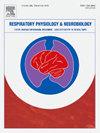急性间歇缺氧治疗可适度改善庞贝病患者的呼吸。
IF 1.6
4区 医学
Q3 PHYSIOLOGY
引用次数: 0
摘要
庞贝病是一种常染色体隐性神经肌肉疾病,其特征是缺乏酸性α-葡萄糖苷酶(GAA),一种在所有细胞中负责溶酶体糖原降解的酶。呼吸窘迫是庞贝病患者的常见症状,由膈肌和颏舌肌的初级呼吸神经肌肉单位以及支配它们的运动神经元无力引起。FDA唯一批准的治疗方法是重组人GAA (rhGAA)的酶替代疗法(ERT),它减缓了运动功能的衰退,延长了预期寿命。然而,ERT不能穿过血脑屏障,因此不能治疗运动神经元中存在的阻碍长期疗效的关键病理。在本研究中,我们试图探索一种通过改善运动神经元功能来改善Pompe患者呼吸的替代治疗方法。治疗性急性间歇缺氧(tAIH)是一种非侵入性治疗方式,在改善脊髓损伤、肌萎缩侧索硬化症、多发性硬化症和中风患者的呼吸和非呼吸运动功能方面取得了成功。在这里,我们对成年Gaa-/-小鼠进行了为期一周的单次tAIH治疗,然后进行了为期4个月的双周tAIH治疗。我们报告了三个关键发现:(1)短期和长期tAIH治疗均可适度改善Gaa-/-小鼠的呼吸;(2)长期taih治疗可适度提高WT小鼠的呼吸反应;(3) Gaa-/-中呼吸的这些趋势改善可能与化学反射激活的变化、后凸的减少以及膈肌中乙酰胆碱受体和膈运动神经元轴突末端重叠的改善有关。本文章由计算机程序翻译,如有差异,请以英文原文为准。
Therapeutic acute intermittent hypoxia modestly improves breathing in Pompe disease
Pompe disease is an autosomal recessive neuromuscular disorder characterized by a deficiency of acid α-glucosidase (GAA), an enzyme responsible for lysosomal glycogen degradation in all cells. Respiratory distress is a common symptom among patients with Pompe disease resulting from weakness of primary respiratory neuromuscular units of the diaphragm and genioglossus and the motor neurons which innervate them. The only FDA approved treatment is enzyme replacement therapy (ERT) of recombinant human GAA (rhGAA) which slows the decline of motor function and extends life expectancy. However, ERT does not cross the blood-brain barrier and thus, is unable to treat the critical pathology present in motor neurons hindering long-term efficacy. In the present study, we sought to explore an alternative treatment for Pompe patients to improve breathing by improving the function of motor neurons. Therapeutic acute intermittent hypoxia (tAIH) is a non-invasive therapeutic modality which has had success in improving respiratory and non-respiratory motor function in patients with spinal cord injury, amyotrophic lateral sclerosis, multiple sclerosis, and stroke. Here, we treated adult Gaa-/- mice with a single, week-long tAIH protocol, followed by bi-weekly tAIH for 4 months. We report three critical findings: (1) both short and long-term tAIH therapy modestly improve breathing in Gaa-/- mice; (2) long-term tAIH-therapy in WT mice moderately elevates breathing responses; and (3) these trending improvements to respiration in Gaa-/- may be related to changes in chemoreflex activation, reduced kyphosis, and improved overlap of acetylcholine receptors and phrenic motor neuron axon terminals in the diaphragm muscle.
求助全文
通过发布文献求助,成功后即可免费获取论文全文。
去求助
来源期刊
CiteScore
4.80
自引率
8.70%
发文量
104
审稿时长
54 days
期刊介绍:
Respiratory Physiology & Neurobiology (RESPNB) publishes original articles and invited reviews concerning physiology and pathophysiology of respiration in its broadest sense.
Although a special focus is on topics in neurobiology, high quality papers in respiratory molecular and cellular biology are also welcome, as are high-quality papers in traditional areas, such as:
-Mechanics of breathing-
Gas exchange and acid-base balance-
Respiration at rest and exercise-
Respiration in unusual conditions, like high or low pressure or changes of temperature, low ambient oxygen-
Embryonic and adult respiration-
Comparative respiratory physiology.
Papers on clinical aspects, original methods, as well as theoretical papers are also considered as long as they foster the understanding of respiratory physiology and pathophysiology.

 求助内容:
求助内容: 应助结果提醒方式:
应助结果提醒方式:


